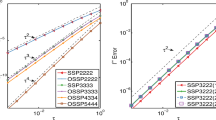Abstract
New optimal, contractivity-preserving (CP), explicit, d-derivative, k-step Hermite–Obrechkoff series methods of order p up to \(p=20\), denoted by CP HO(d, k, p), with nonnegative coefficients are constructed. These methods are used to solve nonstiff first-order initial value problems \(y'=f(t,y)\), \(y(t_0)=y_0\). The upper bound \(p_u\) of order p of HO(d, k, p) can reach, approximately, as high as 2.4 times the number of derivatives d. The stability regions of HO(d, k, p) have generally a good shape and grow with decreasing \(p-d\). We, first, note that three selected CP HO methods: 4-derivative 7-step HO of order 13, denoted by HO(4, 7, 13), 5-derivative 6-step HO of order 13, denoted by HO(5, 6, 13), and 9-derivative 2-step HO of order 13, denoted by CMDAHO(13) compare favorably with Adams–Cowell of order 13, denoted by AC(13), in solving standard N-body problems over an interval of 1000 periods on the basis of the relative error of energy as a function of the CPU time. Next, the three HO methods compare positively with AC(13) in solving standard N-body problems on the basis of the growth of relative positional error and relative energy error over 10, 000 periods of integration. Finally, these three methods compare also well with P-stable methods of Cash and Franco et al. on some quasi periodic, second-order linear and nonlinear problems. The coefficients of selected HO methods are listed in the appendix.




Similar content being viewed by others
References
Barrio, R.: Performance of the Taylor series method for ODE/DAEs. Appl. Math. Comput. 163, 525–545 (2005a)
Barrio, R.: Sensitivity analysis of ODEs/DAEs using the Taylor series method. SIAM J. Sci. Comput. 27, 1929–1947 (2006)
Barrio, R., Blesa, F., Lara, M.: VSVO formulation of the Taylor method for the numerical solution of ODEs. Comput. Math. Appl. 50, 93–111 (2005b)
Butcher, J.C.: The Numerical Analysis of Ordinary Differential Equations: Runge–Kutta and General Linear Methods. Wiley, Chicester (1987)
Cash, J.R.: High order P-stable formulae for the numerical integration of periodic I.V.P. Numer. Math. 37, 355–370 (1981)
Corliss, G.F., Chang, Y.F.: Solving ordinary differential equations using Taylor series. ACM Trans. Math. Softw. 8, 114–144 (1982)
Deprit, A., Zahar, R.M.W.: Numerical integration of an orbit and its concomitant variations. Z. Angew. Math. Phys. 17, 425–430 (1966)
Franco, J.M., Palacios, M.: High-order P-stable multistep methods. J. Comput. Appl. Math. 30, 1–10 (1990)
Gottlieb, S., Ketcheson, D.I., Shu, C.-W.: High order strong stability preserving time discretization. J. Sci. Comput. 38, 251–289 (2009). doi:10.1007/s10915-008-9239-z
Gottlieb, S., Shu, C.-W., Tadmor, E.: Strong stability-preserving high-order time discretization methods. SIAM Rev. 43, 89–112 (2001)
Hairer, E., Nørsett, S.P., Wanner, G.: Solving Ordinary Differential Equations I. Nonstiff Problems. Springer, Berlin (1993)
Hoefkens, J., Berz, M., Makino, K.: Computing validated solutions of implicit differential equations. Adv. Comput. Math. 19, 231–253 (2003)
Huang, C.: Strong stability preserving hybrid methods. Appl. Numer. Math. 59, 891–904 (2009)
Huang, T.Y., Innanen, K.: A survey of multiderivative multistep integrators. Astron. J. 112(3), 1254–1262 (1996)
Hull, T.E., Enright, W.H., Fellen, B.M., Sedgwick, A.E.: Comparing numerical methods for ordinary differential equations. SIAM J. Numer. Anal. 9, 603–637 (1972)
Kennedy, C.A., Carpenter, M.K., Lewis, R.M.: Low-storage, explicit Runge–Kutta schemes for the compressible Navier–Stokes equations. Appl. Numer. Math. 35, 177–219 (2000)
Lambert, J.D.: Numerical Methods for Ordinary Differential Systems: The Initial Value Problem. Wiley, London (1991)
Lara, M., Elipe, A., Palacios, M.: Automatic programming of recurrent power series. Math. Comput. Simul. 49, 351–362 (1999)
Nedialkov, N.S., Jackson, K.R., Corliss, G.F.: Validated solutions of initial value problems for ordinary differential equations. Appl. Math. Comput. 105, 21–68 (1999)
Nguyen-Ba, T., Kengne, E., Vaillancourt, R.: One-step 4-stage Hermite–Birkhoff–Taylor ODE solver of order 12. Can. Appl. Math. Q. 16, 77–94 (2008)
Nguyen-Ba, T., Desjardins, S.J., Sharp, P.W., Vaillancourt, R.: Contractivity-preserving, explicit, Hermite–Obrechkoff ODE solver of order 13. Celest. Mech. Dyn. Astron. 117, 423–434 (2013). doi:10.1007/s10569-013-9520-9
Obrechkoff, N.: Neue Quadraturformeln. Abh. Preuss. Akad. Wiss. Math. Nat. Kl. 4, 1–20 (1940)
Prince, P.J., Dormand, J.R.: High order embedded Runge–Kutta formulae. J. Comput. Appl. Math. 7, 67–75 (1981)
Rabe, E.: Determination and survey of periodic Trojan orbits in the restricted problem of three bodies. Astron. J. 66, 500–513 (1961)
Sharp, P.W.: Numerical comparison of explicit Runge–Kutta pairs of orders four through eight. ACM Trans. Math. Softw. 17, 387–409 (1991)
Steffensen, J.F.: On the restricted problem of three bodies. Danske Vid. Selsk. Mat.-fys. Medd. 30, 1–17 (1956)
Acknowledgments
The anonymous referees are deeply thanked for many constructive comments which have improved this paper considerably. This work was supported in part by the Natural Sciences and Engineering Research Council of Canada. Thanks are due to Martín Lara for supplying the authors with his programs and and sharing his experience.
Author information
Authors and Affiliations
Corresponding author
Additional information
This work was supported in part by the Natural Sciences and Engineering Research Council of Canada.
Appendix: Coefficients of two selected HO methods
Appendix: Coefficients of two selected HO methods
Table 20 of the appendix lists the two selected CP HO methods: HO(4, 7, 13) and HO(5, 6, 13) with their \(c(\text {HO}(d,k,p))\) and \(x_{\text {min}}\) (of the unscaled stability intervals \(( x_{\text {min}}, 0)\)).
Rights and permissions
About this article
Cite this article
Nguyen-Ba, T., Giordano, T. & Vaillancourt, R. Contractivity-preserving explicit multistep Hermite–Obrechkoff series differential equation solvers. Celest Mech Dyn Astr 124, 385–404 (2016). https://doi.org/10.1007/s10569-015-9668-6
Received:
Revised:
Accepted:
Published:
Issue Date:
DOI: https://doi.org/10.1007/s10569-015-9668-6
Keywords
- Contractivity preserving
- Explicit Hermite–Obrechkoff series method
- Multistep methods
- Taylor series methods
- High-precision integration of ODEs
- N-body simulation




